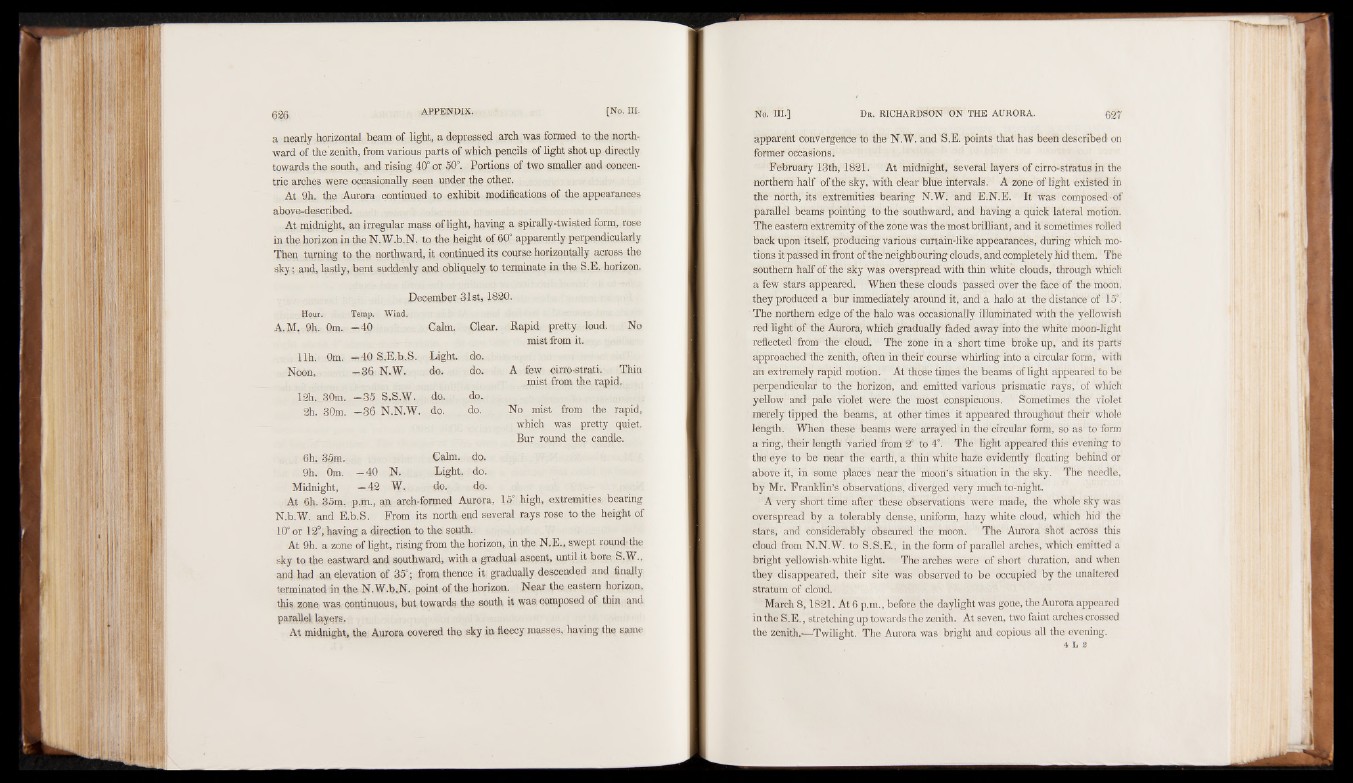
a nearly horizontal beam of light, a depressed arch was formed to the northward
of the zenith, from various parts of which pencils of light shot up directly
towards the south, and rising 40° or 50°. Portions of two smaller and concentric
arches were occasionally seen under the other,
At 9h, the Aurora continued to exhibit modifications of the appearances
above-described.
At midnight, an irregular mass of light, having a spirally-twisted form, rose
in the horizon in the N.W.b.N. to the height of 60° apparently perpendicularly
Then turning to the northward, it, continued its course horizontally across the
sky; and, lastly, bent suddenly and obliquely to terminate in the S.E. horizon.
December 31st, 1820.
Hour. Tejra.pu Wind.
A.M. 9h. 0m. -4 0 Calm. Clear. Rapid pretty loud. No
mist from it.
Ub. 0m. -4 0 S.E.b.S. Light. do.
Noon, —36 N.W. do. do. A few mist cirro-from strati.the rapid.
Thin
12h^30m. -3 5 S.S.W. do. do.
2h. 30m. -3 6 N.N.W. do. do. No mist from the rapid,
6h. 35m. Calm. do.
which was pretty quiet.
Bur round the candle.
CO
03
1o2 Light. do.
Midnight, -4 2 W. do. do.
At 6h. 35m. p.m., an arch-fonned Aurora, 15° high, extremities) bearing
N.b.W. and E.b.S. From its north end several rays rose to the height of
10° or 12°, having a direction to the south.
At 9h. a zone of light, rising from the horizon, in the N.E., swept round-the
sky to the eastward and southward, with a gradual ascent, until it bore S.W.,
and had an elevation of 35°; from thence it gradually descended and finally
terminated in the N.W.b.N. point of the horizon. Near the eastern horizon,
this zone was continuous, but towards the south it was composed of thin and
parAatl leml ildanyeigrhs.t, the Aurora covered the sky in fleecy masses,- having the same
apparent convergence to the N.W. and S.E. points that has been described on
former occasions.
February I3th, 1821. At midnight, several layers of cirro-stratus in the
northern half of the sky, with clear blue intervals. A zone of light existed in
the north, its extremities bearing N.W. and E.N.E. It was composed of
parallel beams pointing to the southward, and having a quick lateral motion.
The eastern extremity of the zone Was the most brilliant, and it sometimes rolled
back upon itself, producing various curtain-like appearances, during which motions
it passed in front of the neighbouring clouds, and completely hid them. The
southern half of the sky was overspread with thin white clouds, through which
a few stars appeared. When these clouds passed over the face of the moon,
they produced a bur immediately around it, and a halo at the distance of 15°.
The northern edge of the halo was occasionally illuminated with the yellowish
red light of the Aurora, which gradually faded away into the white moon-light
reflected from the cloud. The zone in a short time broke up, and its parts
approached the zenith, often in their course whirling into a circular form, with
an extremely rapid motion. At those times the beams of light appeared to be
perpendicular to the horizon, and emitted various prismatic rays, of which
yellow and pale violet were the most conspicuous. Sometimes the violet
merely tipped the beams, at other times it appeared throughout their whole
length. When these beams were arrayed in the circular form, so as to form
a ring, their length varied from 2° to 4°. The light appeared this evening to
the eye to be near the earth, a thin white haze evidently floating behind or
above it, in some places near the moon’s situation in the sky. The needle,
by Mr. Franklin’s observations, diverged very much to-night.
A very short time after these observations were made, the whole sky was
overspread by a tolerably dense, uniform, hazy white cloud, which hid the
stars, and considerably obscured the moon. The Aurora shot across this
cloud from N.N.W. to S.S.E., in the form of parallel arches, which emitted a
bright yellowish-white light. The arches were of short duration, and when
they disappeared, their site was observed to be occupied by the unaltered
stratum of cloud.
March 8,1821. At6 p.m., before the daylight was gone, the Aurora appeared
in the S.E., stretching up towards the zenith. At seven, two faint arches crossed
the zenith.—Twilight. The Aurora was bright and copious all the evening.
4 L 2
f